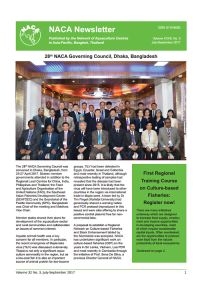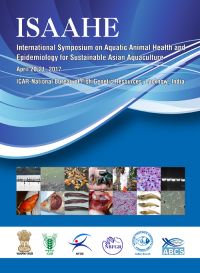The potential for augmentation of fish production and fish-based eco-tourism in Arunachal Pradesh are immense. The landscape of the state is characterised by lofty mountains with snow-clad peaks, dense forests, turbulent streams and a rich diversity of flora and fauna. We review the potential of some of the lakes in the region to support trout fisheries for both recreational fishing and eco-tourism, with a view to providing job opportunities for highland communities.
In this issue:
28th NACA Governing Council, Dhaka, Bangladesh; register for the First Regional Training Course on Culture-based Fisheries; 11th Indian Fisheries and Aquaculture Forum, Kochi, 21-24 November; audio recordings for regional feed consultation now available; tilapia lake virus; Proceedings of the International Symposium on Aquatic Animal Health and Epidemiology for Sustainable Asian Aquaculture; ICAR-CIBA launch "Vanami Shrimpapp", a mobile app on Pacific white shrimp (Penaeus vannamei) farming; Pakistan officials train on aquaculture certification.
These are the proceedings of a symposium convened by the ICAR National Bureau of Fish Genetic Resources, Lucknow, India, from 20-21 April 2017. The symposium included presentations from national and international experts on aquatic animal epidemiology and related disciplines to address a range of risk factors that catalyse horizontal spread of disease, spread of transboundary pathogens and increased disease susceptibility, thereby contributing to strengthening of surveillance efforts, especially in the Indian context.
IDRC and the National University of Singapore (NUS) are offering fellowships for Southeast Asian entrepreneurs, leaders in business, government, and civil society who want to better understand Southeast Asian value chains. The four-day program from 19-22 March 2018 will give participants a useful toolkit of ideas to take full advantage of a connected ASEAN Economic Community. Women leaders and participants from Cambodia, Indonesia, Laos, Malaysia, Myanmar, the Philippines, Thailand, Timor-Leste, and Vietnam are especially encouraged to apply.
This position provides the opportunity for an exceptional candidate to pursue research on governing for food security, equity and resilience in Pacific small-scale fisheries. The appointee will work alongside a WorldFish team working with regional authorities and national governments. The joint appointment will provide the opportunity to collaborate with leading social scientists in the ARC Centre of Excellence for Coral Reef Studies program on policy, institutions and governance.


